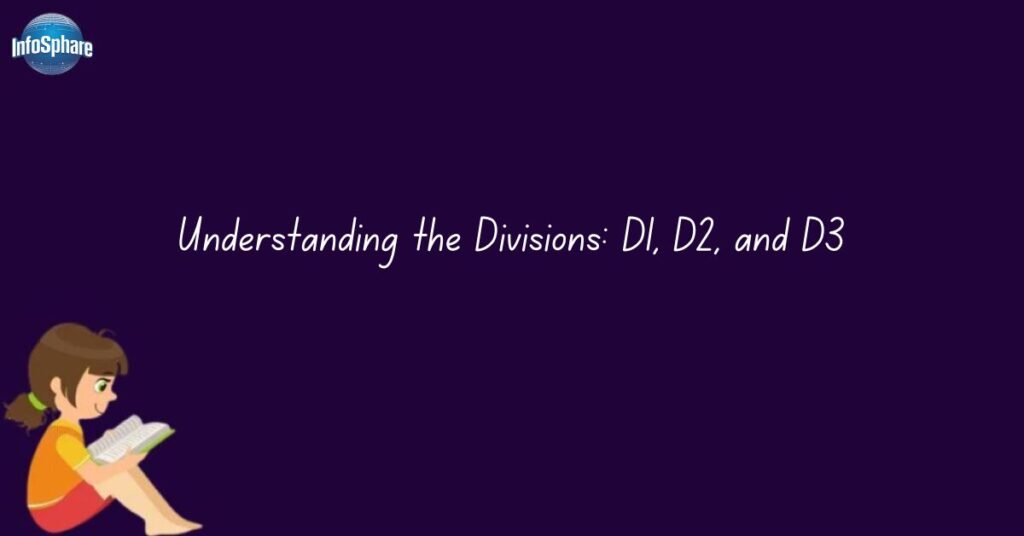In slang, D1 usually means someone is extremely skilled at sports, especially at the college level. It comes from Division 1 (D1), the highest level of college athletics in the U.S. If someone calls an athlete “D1,” they mean that person is talented enough to play for top colleges and might even go pro. People also use it casually to describe someone who is just really good at something, even outside of sports.
Besides sports, D1 can have other meanings in slang. Some people use it to describe something top-tier or elite. For example, if a person is very attractive or fit, someone might jokingly call them “D1.” It’s a way of saying they are the best, just like top athletes. Slang changes over time, so the meaning of D1 might keep evolving.
Even though D1 mostly refers to sports, it’s also used in funny or exaggerated ways. Someone might say, “That pizza was D1” to mean it was amazing. Or a person might hear, “Give me that D1,” as a playful compliment. Whether it’s about sports, looks, or just being great at something, D1 is all about being the best!
Understanding the Divisions: D1, D2, and D3
If you’re a student-athlete or a sports enthusiast, you’ve probably heard of D1, D2, and D3. These terms refer to the three athletic divisions of the National Collegiate Athletic Association (NCAA), which governs college sports in the U.S. Each division has different levels of competition, scholarships, and student-athlete experiences. Understanding these differences can help athletes make informed decisions about their college careers.

Division 1 (D1): The Highest Level of Competition
D1 schools have the most competitive athletic programs and attract top-tier athletes. These colleges often have large student populations, significant funding, and state-of-the-art facilities. D1 athletes dedicate a substantial amount of time to training, games, and travel. Many of these schools offer full-ride scholarships, covering tuition, room, board, and other expenses. Sports at this level receive extensive media coverage, and athletes have higher chances of turning professional.
Division 2 (D2): A Balance Between Athletics and Academics
D2 schools also compete at a high level but place a greater emphasis on balancing academics and athletics. These schools may offer partial scholarships, meaning student-athletes may still need additional financial aid. D2 teams are competitive but may not have the same national recognition as D1 programs. However, they still provide excellent opportunities for athletes to develop their skills while maintaining a strong academic focus.
Division 3 (D3): Academics First, Athletics Second
D3 schools prioritize academics while still offering competitive athletic programs. Unlike D1 and D2, D3 schools do not offer athletic scholarships, but student-athletes can receive merit-based and need-based financial aid. D3 athletes often have more flexibility with their schedules, allowing them to participate in extracurricular activities and focus on academics. While the competition level is lower than D1 and D2, these programs still produce talented athletes and competitive teams.
Key Differences Between D1, D2, and D3
| Feature | D1 | D2 | D3 |
| Competition Level | Highest | High | Moderate |
| Scholarships | Full-ride & partial | Partial scholarships | No athletic scholarships |
| Commitment | Very high | Moderate to high | Lower commitment |
| Academic Focus | Balanced but sports-focused | Strong academic-athletic balance | Academics first, athletics second |
| Media Exposure | Extensive | Moderate | Limited |
Which Division is Right for You?
Choosing between D1, D2, and D3 depends on your athletic ability, academic goals, and lifestyle preferences. If you aspire to play at the highest level and possibly go pro, D1 is the best path. If you want a mix of competitive sports and academics, D2 might be the right fit. If you’re focused on education but still love playing sports, D3 offers the best balance.
Regardless of the division, student-athletes have incredible opportunities to grow, compete, and succeed. The key is to choose a school that aligns with both your academic and athletic aspirations.
Must Read this Magical Slang: Fyrtrd: A Word Full of Mystery and Emotion
D1 Meaning Slang Urban Dictionary
In slang, D1 usually refers to a top-level athlete who is skilled enough to earn a scholarship to a Division 1 (D1) college. Division 1 schools have the most competitive sports programs, so calling someone “D1” means they are extremely talented in their sport. For example, if a football player dominates a game, people might say, “That dude is D1!”

However, D1 can also have other slang meanings. Some people use it to describe something top-tier or elite, not just in sports. It can also be used in a completely different context, such as describing an attractive or well-built person. In some cases, “D1” is jokingly used in a more explicit way, referring to physical appearance.
Overall, the meaning of D1 in slang depends on the context. In most cases, it highlights excellence, high skill, or top-level performance, especially in sports. However, like many slang terms, its meaning can change based on how people use it in conversations.
Decoding the Differences: Intensity and Competitiveness
When it comes to college sports, the NCAA (National Collegiate Athletic Association) divides schools into three divisions: D1, D2, and D3. These divisions vary in intensity, competitiveness, and scholarship opportunities. D1 schools have the most competitive teams, with the best athletes and the highest level of training. These programs demand major commitment, often making sports the main focus of a student-athlete’s life.
D2 schools are still competitive but with a slightly lower intensity than D1. Athletes here may have more time to balance academics and social life, though they still train and compete at a high level. Scholarships are available, but full-ride scholarships are less common than in D1. Meanwhile, D3 schools prioritize academics over athletics. The competition level is lower, and athletic scholarships aren’t offered. However, D3 athletes still play competitively and often receive financial aid based on academics or other achievements.
In short, the main difference between D1, D2, and D3 is the level of commitment and competitiveness. If you’re aiming for a professional sports career, D1 is the best path. If you want a balance between sports and academics, D2 could be ideal. And if you love playing sports but want to focus mainly on school, D3 is a great option.
Financial Aid: Unveiling the Possibilities
Financial aid for student-athletes varies depending on whether they compete at a D1, D2, or D3 school. D1 athletes often receive the most financial support, with many earning full-ride scholarships that cover tuition, housing, meals, and other expenses. These schools have the biggest budgets and offer more opportunities for NIL (Name, Image, and Likeness) deals, allowing athletes to make money through sponsorships and endorsements.

D2 athletes also receive scholarships, but they are usually partial scholarships rather than full rides. This means athletes might have to pay for some of their education, but they can still use their sports skills to help reduce costs. D2 schools balance academics and athletics, so students may also qualify for academic scholarships or financial aid based on merit.
In contrast, D3 schools do not offer athletic scholarships. However, athletes can still receive financial aid through academic scholarships, grants, or need-based assistance. Since their scholarships aren’t tied to sports, D3 athletes have more flexibility—if they decide to stop playing, they won’t lose their financial aid. This makes D3 a great option for those who want to focus on academics while continuing to play the sport they love.
Recruiting: Charting the Path to Collegiate Athletics
The recruiting process for college athletics varies by division, with D1, D2, and D3 schools following different rules and timelines. D1 schools have the most competitive recruiting process, often scouting athletes as early as their freshman or sophomore year of high school. Coaches actively seek top-tier talent, and athletes must meet strict eligibility requirements set by the NCAA. Full scholarships are more common, making D1 recruiting highly selective.
D2 schools also recruit talented athletes but with less intensity than D1. Coaches may wait until later in high school to make offers, and scholarships are usually partial rather than full rides. However, D2 recruiting still requires commitment, and athletes must showcase their skills through highlight reels, club teams, and direct communication with coaches.
D3 recruiting is the most relaxed, as schools do not offer athletic scholarships. However, coaches still look for dedicated athletes who can balance academics and sports. Since there are fewer restrictions, student-athletes often have more control over their recruiting process, allowing them to focus on both their education and athletic career.
Athletic Budgets: Unveiling the Playing Field
The athletic budgets for D1, D2, and D3 schools vary significantly, influencing everything from facilities and scholarships to travel expenses and coaching staff. D1 schools have the largest budgets, often funded by television deals, sponsorships, and ticket sales. These schools invest heavily in state-of-the-art training facilities, top-tier coaching staff, and nationwide travel for competitions. The financial backing allows D1 programs to offer full-ride scholarships and attract elite athletes.

D2 schools operate on moderate budgets, balancing athletic competition with financial constraints. While they provide partial scholarships, their resources are smaller than those of D1 schools. Travel is usually regional rather than national, and facilities may not be as advanced. However, D2 programs still prioritize athletics, ensuring competitive training environments while allowing athletes to focus on academics.
D3 schools have the smallest athletic budgets, as they do not offer athletic scholarships. Their funding primarily comes from student tuition and institutional support. While their facilities and travel budgets are more limited, they emphasize a well-rounded student-athlete experience, where academics take priority. Despite smaller budgets, D3 programs still provide competitive opportunities for athletes who love the game but prioritize their education.
Also Read this: CNC Meaning: Internet Urban Slang
What Does D1 yapper Mean
D1 yapper is a slang term used to describe someone who is exceptionally skilled at talking, boasting, or trash-talking—similar to how a Division 1 (D1) athlete is considered top-tier in sports. The term is often used in sports, gaming, or everyday conversations to highlight someone with elite verbal skills, whether it’s hyping up a team, talking smack, or being incredibly persuasive in arguments.
For example, if someone constantly hypes up their skills or talks a big game before a competition, people might say, “He’s got a D1 yapper.” This means their ability to talk and command attention is as strong as a D1 athlete’s performance in their sport. It’s often used in a playful or competitive way, especially among friends or teammates.
The phrase can also apply to comedians, rappers, or even fast talkers in business—anyone who has a sharp tongue and knows how to use it effectively. Whether it’s trash talk on the basketball court or smooth-talking in negotiations, a “D1 yapper” stands out as a master of words.
What Does D1 Mean On Snapchat
On Snapchat, “D1” is commonly used to represent Day 1 in the context of Snapchat streaks. A Snapchat streak occurs when two users send each other snaps (not just chats) for consecutive days. Each day the streak continues, the number of days increases, and users typically see a flame emoji next to their names with a number indicating how many days the streak has lasted.
When you see “D1”, it usually indicates that the streak has just begun. This could be a way of marking the first day that both users have sent snaps to each other, signaling the start of their streak. Snapchat users often take pride in maintaining long streaks, with some even going for hundreds or even thousands of days.
However, it’s important to note that “D1” isn’t always a standard term in every Snapchat conversation. Some people may use it simply to celebrate the start of a streak, while others might use it in different contexts, such as referencing a special event or milestone. Either way, it typically refers to the beginning of something significant on Snapchat.
Landing a Spot: The Path to Collegiate Competition
Ah, the pursuit of a spot on a college team, an exciting journey where dreams meet reality. The numbers tell a clear story, showing just how tough the competition is and how selective college sports can be. Let’s dive into this journey, guided by the stats that shape the futures of hopeful athletes.
In D1, where the stakes are highest, the path is tough and demanding. According to NCAA data from 2020, only 7.3% of varsity high school football players made it to college sports, and just 2.9% of them landed a spot in D1. Wrestlers had even harder odds, with only about 3% competing in college and only 1% making it into D1. These numbers show how challenging D1 competition is, where the top athletes battle for success.
However, as we explore the wide world of college sports, we see that each division holds its own share of talented athletes. Around one-third of college athletes play in each division. So, if you’re lucky enough to enter the world of college sports, you’ll need to find your way. Whether you make it to D1, D2, or D3, you will be among the accomplished few, ready to face the challenges and wins that lie ahead.
The Commitment: Balancing Athletics and College Life
The commitment required to succeed in both sports and academics is a tightrope walk, where each step matters. Let’s break down the time and energy needed in each division, painting a clear picture of what life is like for athletes across different levels.
For D1 athletes, the commitment is intense. Their schedules are packed year-round, with little downtime. Training, practices, and competitions dominate their lives. Some even take summer classes to keep up with their coursework. During the off-season, D1 athletes focus on improving their skills, keeping their fitness levels high, and catching up on schoolwork. The constant travel for games, often across the country, becomes a regular part of their routine. In this world, athletics come first, and everything else follows closely behind.
In D2, the commitment is somewhat more balanced. While athletics are still a top priority, the schedule isn’t as demanding as in D1. Many D2 athletes enjoy summers off and face less intense travel, often sticking to a more regional competition schedule. Training and practices are still rigorous, but athletes might have a little more flexibility when it comes to managing academic responsibilities and personal time. Though it’s still challenging, there’s a bit more room for other activities outside of sports.
Must Read this Magical Slang: Fyrtrd: A Word Full of Mystery and Emotion
D3 athletes, on the other hand, enjoy the most flexibility. Their training schedules are lighter, and the distances they travel for games are shorter. With summers off and less pressure during the off-season, D3 athletes have the freedom to explore academic interests, internships, and other personal endeavors. While D3 sports still require dedication and time, the experience is often more well-rounded, with athletes able to balance their athletic pursuits with their studies and extracurricular activities.
No matter the division, the journey of a college athlete requires dedication, sacrifice, and a well-managed schedule. Each level offers a different balance, with D1 demanding the most focus, D2 providing a bit of breathing room, and D3 offering the most flexibility for a diverse college experience.
What does D1 mean TikTok
In the context of TikTok, D1 typically refers to Division 1 sports. This is part of the NCAA (National Collegiate Athletic Association) in the United States, where the most competitive and high-profile college athletics are found.

However, on TikTok, users often create content that discusses or features athletes, and “D1” is used as shorthand for top-tier collegiate athletes who play for the most competitive sports teams in Division 1. It’s common to see videos about the hard work, pressure, and lifestyle that come with being a D1 athlete, as well as tips or memes that reference the intensity of D1 sports.
Sometimes, “D1” can also be used as a term of status or excellence in other contexts, implying something that is at the highest level.
The Spirit of Competition and Post-College Potential
The spirit of competition in college sports is more than just about winning—it’s about pushing limits, building character, and preparing for what lies beyond the playing field. As athletes grind through their college years, the lessons learned and the relationships built often play a pivotal role in shaping their futures, both inside and outside of athletics.
In Division 1, where the stakes are the highest, athletes often find themselves under immense pressure. The intense competition, combined with rigorous training schedules and travel commitments, molds individuals who are not only physically elite but also mentally tough. Many of these athletes dream of going pro, whether in their sport or in a related career, and for some, college sports serve as a stepping stone to that next level.
The chances of turning a D1 career into a professional one are slim, but for those who make it, the rewards are enormous—both financially and in terms of fame. However, even for those who don’t go pro, the experience gained is invaluable, opening doors to future opportunities in coaching, sports management, and beyond.
In Division 2, the competition remains fierce, but with a little more room for balance. Athletes here still dream big, but many are more focused on the educational opportunities that college provides. Post-college, D2 athletes often transition into careers where the skills honed on the field—teamwork, perseverance, and leadership—serve them well in professional settings. Whether in business, healthcare, or tech, the work ethic developed through D2 sports is often viewed as a tremendous asset by employers.
Meanwhile, Division 3 athletes might experience the most balance between sport and academics. The competition is still strong, but D3 athletes are typically more focused on their education and extracurricular interests. Many D3 athletes choose careers based on their degrees, but the discipline and commitment gained from their time in sports often lead to successful careers in diverse fields. The friendships and networks built through sports can provide lasting benefits, whether through mentorships, alumni connections, or learning to juggle responsibilities in a real-world setting.
Regardless of the division, the spirit of competition teaches invaluable life skills: resilience, discipline, and the drive to be better each day. Post-college, the connections, experiences, and personal growth achieved through college athletics become just as important as the athletic achievements themselves.
Whether they continue in sports or shift gears to new endeavors, former athletes often excel due to the mental fortitude, work ethic, and leadership qualities they developed during their time on the field. College sports, regardless of the division, leave an enduring legacy that extends well beyond graduation day.
Choosing the Right Division: A Personal Journey
Choosing which division to pursue in college sports is not a one-size-fits-all decision—it’s a journey shaped by an athlete’s passion, goals, and personal values. For some, the allure of Division 1 (D1) athletics is undeniable. The level of competition, the spotlight, and the potential for professional opportunities make it a dream for athletes aiming to reach the highest level of their sport. The thrill of competing against the nation’s best, the exposure that comes with being on a D1 team, and the possibility of going pro can be powerful motivators for those driven to push their sport—and themselves—to the limit.
Yet, for others, the choice may not be about aiming for a professional career. Division 2 (D2) and Division 3 (D3) offer an entirely different, more balanced college experience. For athletes who aren’t focused on going pro, these divisions provide an opportunity to play at a competitive level without sacrificing academics or personal interests. The decision becomes more about finding harmony between athletic passion and a well-rounded college life.
In D2, athletes may still compete at a high level, but they also have the flexibility to explore their academic and career ambitions with less of the grueling time commitment found in D1. The pace may be more manageable, but the level of competition is still intense, making it ideal for those who want to play competitively without the overwhelming pressure.
D3, on the other hand, represents a balance that allows athletes to thrive both in their sport and in their studies or other extracurricular pursuits. While the competition remains strong, the focus is often on fostering a well-rounded college experience. D3 athletes can pursue passions outside of sports, including internships, research, and leadership roles, while still competing at a high level.
Ultimately, whether it’s the elite competition of D1, the balanced challenge of D2, or the holistic experience of D3, the decision is deeply personal. Each division offers a unique set of opportunities, and choosing the right one depends on how an athlete envisions their college experience and how much they want sports to shape their future. The decision involves more than just sport—it’s about finding the right fit for an individual’s academic goals, career aspirations, and personal growth.
Frequently Asked Questions
What is the meaning of D1?
D1 refers to Division 1 in collegiate sports, representing the highest level of competition within the NCAA (National Collegiate Athletic Association). Athletes in D1 schools compete at the most competitive level, with schools often offering full athletic scholarships and a rigorous schedule. D1 athletics typically include high exposure, extensive training, and the opportunity for athletes to pursue professional careers in their respective sports.
What is D1 on TikTok?
On TikTok, D1 often refers to “Day 1”, meaning the beginning of something—usually referring to the first day of a journey, challenge, or process. It’s used to mark the start of a new commitment or phase, especially when it comes to fitness, goals, or a series of videos.
What does D1 mean in media?
In media, D1 could refer to a variety of things depending on the context. It might denote Division 1 in sports or it could stand for Digital 1, referring to a digital platform, broadcast network, or channel. It can also mean “Day 1”, a phrase signifying the beginning of an event or coverage.
Does D1 mean Day One?
Yes, D1 can mean “Day One” in some contexts, especially on social media platforms like TikTok. This usage signifies the first day of an experience, project, or commitment, implying the start of something significant. It’s commonly used to document the journey or progress of a specific challenge or initiative.
Can D3 athletes receive any financial aid based on their athletic accomplishments?
Yes, D3 athletes can receive financial aid, but it’s important to note that athletic scholarships are not offered in Division 3. However, D3 schools can provide need-based financial aid and academic scholarships that athletes may qualify for based on their financial need or academic performance. While D3 schools can’t offer sports-specific scholarships, they can still support athletes through other types of financial assistance.
What is the difference in recruiting timelines between D1, D2, and D3 athletics?
The recruiting timelines can vary greatly across the three divisions:
- D1 recruiting tends to start earlier, often during an athlete’s sophomore or junior year of high school. Coaches are more actively involved in recruiting, and the process can be highly competitive and time-sensitive.
- D2 recruiting usually starts later, around the junior year, and can continue into senior year. D2 schools often have more flexible timelines compared to D1, though the competition remains high.
- D3 recruiting generally happens later and can extend even after high school graduation. While still competitive, D3 schools are typically less aggressive in early recruitment, allowing athletes more time to decide on their future.
How do athletic budgets differ among the three divisions?
Athletic budgets vary significantly between the divisions:
- D1 schools generally have the largest athletic budgets, with high revenues from ticket sales, sponsorships, and media rights. These funds are used for top-notch facilities, extensive travel, and high-level training programs.
- D2 schools typically have smaller budgets, though they still invest significantly in athletics. The focus is often on regional competitions and creating a balance between athletics and academics.
- D3 schools have the smallest budgets and often do not generate significant revenue from sports. As a result, their athletic programs are more about offering a quality experience for athletes rather than making a profit. They focus on fostering a well-rounded college experience and community involvement.
Can I switch divisions if I start as a D1 or D2 athlete but later decide to compete at the D3 level?
Yes, it is possible to switch divisions if you initially start in D1 or D2 and later decide to compete in D3, though the process can be complex. The NCAA rules require athletes to maintain eligibility, and the switch might involve considerations such as scholarship status, eligibility clock rules, and transfer regulations. Each case is unique, so it’s important to consult with both the current and prospective schools and the NCAA to fully understand the requirements and ensure eligibility.
Must Read these magical slangs:
- NMMS Meaning in Text: Quick Guide with Examples
- What is the HYB Meaning in Text and Why It’s So Popular?

Welcome! I’m glad you’re here. My name is Thomas, and this blog is dedicated to English Grammar and more.
I started this blog to share my Grammar site, and it has evolved into a resource where I provide easy and practical tips to help you for better Grammar.



